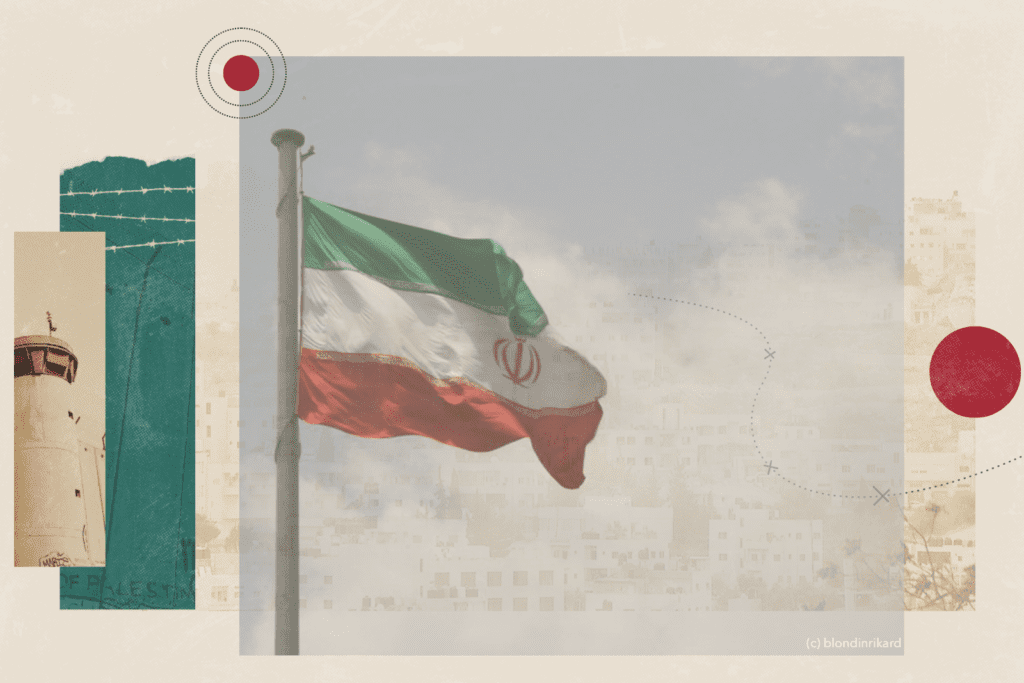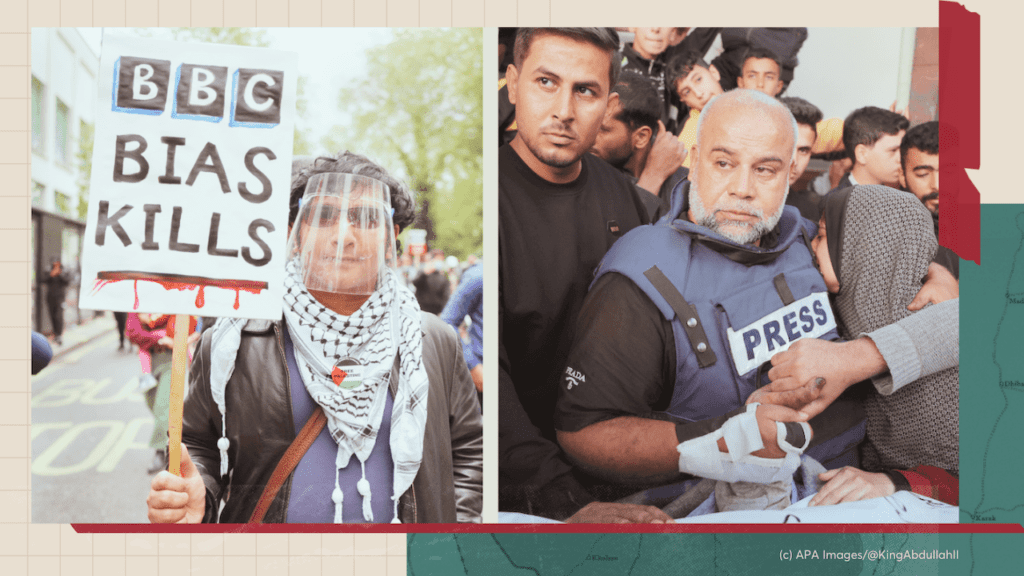- Topics
-
Topics
See our analysis on civil society and how it shapes culture, politics, and policies
Read our insights on the shifting political landscape and what it means for Palestine
Learn more about the policies and practices shaping the Palestinian economy
Strengthen your understanding of the unique conditions for Palestinian refugees across the Middle East
-
- Analysis
-
Analysis
In-depth analysis on existing or potential policies that impact possibilities for Palestinian liberation.
Insights and perspectives on social, political, and economic questions related to Palestine and Palestinians globally.
Concise analysis into a specific policy, its background and implications.
Commentary that brings together insights from multiple analysts.
Compilations of past Al-Shabaka works surrounding a specific theme.
Longer-form, ad hoc projects that seek to confront research questions outside the scope of our regular analysis.
A policy-driven research initiative by Al-Shabaka: The Palestinian Policy Network.
Our monthly webinar series that brings together Palestinian experts.
Featured
While it remains unclear how and when Israel will respond to Iran’s operation, geopolitics have undoubtedly already shifted. In this roundtable, Al-Shabaka analysts Fadi Quran, Fathi Nimer, Tariq Kenney-Shawa, and Yara Hawari offer insights on the regional impact of Iran’s recent maneuver and situate the ongoing genocide in Gaza within this broader context.


 +Mainstream media coverage of the genocide in Gaza throughout the West has highlighted not only deep biases in favor of the Israeli regime, but also the ease in which Palestinians are dehumanized. In this commentary, Yara Hawari details Israel’s strategy to strip Palestinians of their humanity in the public realm, as well as the role of Western media in advancing Israel’s aims. She reveals consistent patterns of journalistic malpractice since October 7, 2023, and concludes that the Western outlets are inescapably complicit in the Israeli regime’s genocide against the Palestinian people of Gaza.
+Mainstream media coverage of the genocide in Gaza throughout the West has highlighted not only deep biases in favor of the Israeli regime, but also the ease in which Palestinians are dehumanized. In this commentary, Yara Hawari details Israel’s strategy to strip Palestinians of their humanity in the public realm, as well as the role of Western media in advancing Israel’s aims. She reveals consistent patterns of journalistic malpractice since October 7, 2023, and concludes that the Western outlets are inescapably complicit in the Israeli regime’s genocide against the Palestinian people of Gaza. Yara Hawari· Apr 3, 2024
Yara Hawari· Apr 3, 2024
-
- Resources
- Media & Outreach
- The Network




Gaza Between Occupation, Division, and COVID-19: Confronting Total Collapse
Introduction
Gaza has always been unique among the different parts of Palestine. Its current particularity stems from being caught between three major variables exacerbating its collapse: the Israeli occupation, division in Palestinian leadership, and the COVID-19 pandemic. This reality raises socio-political questions about the role of these factors in advancing social collapse in Gaza, and about changes in the values of resilience and steadfastness among Palestinians in Gaza.1
Despite the attempts of Gaza’s inhabitants to survive and achieve stability in their daily lives, the consequences of occupation, political division, and the pandemic have eroded the foundations of perseverance amongst them. Indeed, Palestinians in Gaza have suffered from societal fragility, uncertainty, and turbulence that have forced them to live in imaginary communities that cling to fantasy in order to survive.
This commentary describes Gaza’s reality in light of the three major variables. It explores unfolding transformations within Gaza’s civil society to counter impending collapse, including social initiatives such as the Great March of Return, the “We Want to Live” movement, and other initiatives on social media. It concludes with reflections on the future of Gaza based on interviews with activists and young Palestinians who have lived this reality since their childhood.
Gaza Between Occupation and Division
Gaza sits on 360 square kilometers, or 1.3% of the total area of historic Palestine. With a population of around 2.05 million as of 2020, 1.4 million males and 1.01 million females, Gaza is the world’s most densely populated territory with 5,600 inhabitants per square kilometer.
Palestinians in Gaza continue to live under catastrophic conditions due to the Israeli siege now in its fourteenth year, three bloody wars in 2008, 2012, and 2014 in which 3,800 Palestinians were killed, as well as intermittent and devastating Israeli military assaults. In addition, Gaza’s economic and living conditions are at their worst, with unemployment exceeding 70% during the COVID-19 crisis.
The Palestinian Authority’s (PA) sanctions against Gaza, the increased taxation by the de-facto government in Gaza, the electricity and water crises, in addition to food insecurity, have all led to a decline in investments and buying power in Gaza as the poverty rate exceeded 53%. These indicators reflect the damage caused by the Israeli occupation and the division between Hamas and the PA that has hampered sociopolitical development. This reality suggests bleak prospects for the future of Gaza, a future of continued peril and disintegration.
In 2012, UNICEF and the UN Relief and Works Agency for Palestine Refugees (UNRWA) published a report titled “Gaza in 2020, A livable place?” in which they projected the population in Gaza to grow from 1.6 million to 2.1 million by 2020, with a concentration of 5,800 inhabitants per square kilometer. This figure has been exceeded by a high margin.
The report indicated that the fundamental infrastructure for electricity, water and sanitation, and municipal and social services, was struggling to keep pace with the needs of the growing population. However, the report neither factored in natural disasters and pandemics like COVID-19, nor predicted the savage war of 2014. One can thus undoubtedly conclude that Gaza has already been absolutely unlivable for some time now, and is arguably in a state of post-collapse.
Gaza has already been absolutely unlivable for some time now, and is arguably in a state of post-collapse Click To TweetThe Israeli regime has managed to not only besiege Palestinians in Gaza, but to also project their image internationally as a hostile people. Indeed, Israel has killed hundreds of peaceful Palestinian demonstrators during the Great March of Return. To this day, it controls and restricts the import of vital medical equipment and other materials of importance to a variety of sectors in Gaza. It imposes strict restrictions on the movement of goods, and with ongoing military bombardments, it has managed to destroy vital infrastructure. Beyond material restrictions, the Israeli regime restricts Gazans’ freedom of movement, effectively trapping them in a territory it continues to actively destroy.
The ongoing division in Palestinian leadership between Hamas and the PA has also had serious implications for Gaza’s inhabitants. One result of this power struggle has been the complete separation between governing institutions in Gaza and the West Bank with the establishment of two completely distinct authorities and governments. Within this framework, the division has formally institutionalized factional politics and has effectively devastated the Palestinian national project. In effect, this has destroyed the credibility of liberation leadership, and has diminished the trust of Palestinians – and especially of Palestinians in Gaza – in the effectiveness and usefulness of the struggle. Finally, the division of leadership into two authoritarian camps has eroded public freedoms and the political, civil, economic, social, and cultural rights of Palestinians in Gaza.
Gaza During COVID-19
On March 22, 2020, the Palestinian Ministry of Health in Gaza recorded the first cases of COVID-19 in two travelers returning from Pakistan. Subsequently, the government closed popular markets, halls, mosques, restaurants, cafes, and most shops. Nearly two months later, it permitted the reopening of all commercial establishments provided that they undertake preventive measures and enforce social distancing. In late August 2020, the ministry discovered four domestic cases of COVID-19 infections, the sources of which they could not trace, and later announced further infections.
In response to domestic infections, the Ministry of the Interior declared a state of emergency and a two-day curfew in Gaza, quarantining all governorates and enforcing full closures. These were later eased in light of an escalation in Israeli military attacks, and a sharp decline in electricity supplies. The de-facto government failed to learn from the ramifications of the previous closure, especially on day laborers, or to propose measures to assist them financially. In addition, the Israeli regime restricted the import of medical test kits into Palestinian territories.
Since the detection of COVID-19 in early 2020, the number of infections has exceeded 45,000. According to Mahmoud Abdul-Hadi, an expert on civil society institutions, COVID-19 relief efforts in Gaza mostly concentrated on quarantine centers and in the early months of the pandemic, despite many humanitarian relief initiatives, including decentralized community campaigns, civil society institutions, international organizations, Hamas ministries, and the Waqfat Ezz (stand with dignity) Fund. He added that aid has markedly decreased compared to its levels in March, further aggravating the crisis as infection cases rise and overwhelm medical team capacity and crisis management efforts, which had led to further closures that continue to adversely impact Palestinians in Gaza.
The Ramifications of Collapse on Gaza’s Palestinians
The reality in Gaza has shifted from open resistance to one of civil disobedience, as Gazans’ attempts to survive have boiled down to three behavioral options: withdrawal, surrender, or confrontation. A person withdraws when they fail to change their reality and reclaim their rights, and their only option becomes to escape after their means of action have been usurped. Withdrawal in Gaza means to travel, which is particularly common among youth.
To surrender means to reluctantly acclimate with one’s reality, a behavior that engenders a feeling of defeat, failure, and self-condemnation. Judging from their transformations following their failed innovative attempts, one may say that many young Palestinians in Gaza have lost their sense of purpose and desire to live.
Those who choose confrontation continue to confront the status quo with all means available, be they peaceful or armed, and with a great deal of effort placed in educational, community service, and relief activities. They thereby alternate between moments of temporary inability to continuous action.
The COVID-19 pandemic has complicated Gaza’s economic, political, and social conditions, and has exposed the fragility of society. Individualist tendencies have increased amongst Gaza’s Palestinians, along with anxiety, confusion, and uncertainty. Their political and social participation has decreased, and social values have decayed. The pandemic has also created a political vacuum and lack of transparency at the level of decision-making.
Many young Palestinians in Gaza have lost their sense of purpose and desire to live Click To TweetNowadays, Gaza is overpowered and shows little signs of life, lacking the basic foundations that would enable resilience and steadfastness, whether in the context of the liberation movement or otherwise. The result has been a continuing downward spiral towards social and individual isolation.
Simply put, Palestinians in Gaza are haunted by social misery, violence, and wars every second of their lives. Social inequalities have increased, while the marginalized and disadvantaged in society no longer have rights and live in limbo.
Confronting Total Collapse
The Great March of Return
Residents of Gaza take pride in the Great March of Return that began in 2018, as some consider it a new form of struggle against the occupation. And although the organizing body in charge of the Great March of Return decided to limit the rallies to national occasions on December 26, 2019, the large and ongoing demonstrations have represented a popular activity that engages individuals and families, and its effects on Gaza’s society are palpable.
Routinely on Fridays, thousands of Palestinians in Gaza headed eastwards to the borders with the part of Palestine occupied in 1948, setting their right of return in motion and fantasizing about returning to the homeland. After all, roughly 70% of Gaza’s population is internally displaced refugees from lands occupied by Israel in 1948. In effect, on Fridays, Gazans marched to return to their homes.
The rallies were peaceful, inclusive, non-partisan and decentralized, and were founded on Palestinians’ desire to reclaim their rights without clashing directly with the occupation army. However, the occupation regime did not see it this way. Over the course of 2018 and 2019, 214 Palestinians were killed, including 46 children, with over 36,000 injuries, including 8,800 children. Many of those injured remain in dire need of rehabilitative care.
From another perspective, the rallies changed from a tool of struggle to a tool of political bargaining with the advent of the “breaking the siege” slogan, which gave the Israeli government the excuse to attack demonstrators. Additionally, it prompted certain political forces including Fatah and the Democratic Front to withdraw from the rallies because their objectives changed.
Politically, Hamas benefited from the rallies by entering into unannounced talks with Israel in order to promote de-escalation between Israel and the Palestinian factions. In addition, the Qatari ambassador, Mohammad Al-Emadi, visited the marchers’ camps in eastern Gaza on November 9, 2018 and, with Israel’s approval, brought along a Qatari grant of $15 million in order to pay the salaries of Hamas employees. The next day, fuel supplies were resumed to Gaza’s power plant.
Palestinians in Gaza counted on their leadership to seek political reconciliation and end the division, to abstain from bargaining with the occupation, and to adopt the Great March of Return as a means to reclaim the right of return. But they were soon disappointed. Hamas’s actions towards the demonstrating masses represented a loss of the sense of national identity, and of the values underpinning the right of return.
The “We Want to Live” Movement
Palestinians in Gaza grew tired of their living conditions and the status quo, and thus shifted from resistance to civil disobedience and rebellion. It was in this context that the “We Want to Live” Movement (bidna n’eesh) emerged on March 14, 2019, urging Gaza’s inhabitants to take to the streets in protest. The movement called on its followers to come out with kitchen cookware and utensils as a symbol, but they were surprised by the violent reaction of Hamas security forces who arrested families, journalists, and human rights defenders. They also orchestrated simultaneous demonstrations under the pretext of suffering from the salary crisis and the PA sanctions against Gaza.
The activists involved in the movement said they were shocked during interrogations as Hamas security forces invoked “treason” in their questions and purported that the “We Want to Live” demonstrators “worked against the resistance.” However, the activists protested issues of unemployment, and rising prices and taxes. They did not protest against Hamas or side with the PA; rather, they were standing for themselves.
Hamas’s reaction to this movement gives a clear indication of the amount of repression targeting public freedoms in Gaza, and the ways the political authorities have treated, and defamed, those agitating for basic improvements in living conditions as “collaborators against the resistance.” In fact, such a charge of treason is so profound that it provides sufficient grounds to refer the case to the Military Court in Gaza, where the accused faces a bleak and unknown fate.
The repercussions point to the crisis of the security apparatus in Gaza, and Hamas’s totalitarian rule which it justifies on grounds that it protects the citizens. This has, in fact, eroded steadfastness in Gaza, as it politicizes the resistance and works to render it the monopoly of a particular group.
Taking to Social Media
Like the rest of the world, Palestinians in Gaza circulate information on social media platforms such as Facebook and Twitter, including satires of political news in the form of jokes and memes. Indeed, we can think of the virtual space as one that some have adopted as a field for spontaneous critique, away from factional allegiance, and amounting to its own kind of social mobilization.
Given the increasing oppression of their right to freedom of expression, social media platforms have also become a means for Palestinians in Gaza to publicly shame authorities from across the political spectrum. In this way, public shaming has become a digital weapon that Gazans frequently use to express their anger and raise awareness about critical issues, such as in cases where families use violence against their female members, and in cases of political and social extortion against ordinary citizens.
Recently, Palestinian activists in Gaza launched an online campaign, “Down with Jawwal,” against the Palestine Cellular Communications Company, Jawwal, to protest its high prices, particularly in light of the difficult conditions in besieged Gaza. Online activism ensures social rather than formal immunity, speaks the mind of the public, and constitutes a true expression of marginalized groups. As such, it enhances the structural balance of society, reclaiming visibility across the collective, and minimizing individualist tendencies.
The pandemic has reinforced the Zionist principle of ‘divide and rule,’ while the division in Palestinian leadership has further entrenched fragmentation, the state of anomie, and social fragility Click To TweetWhile social activism in the street ceased and moved to online platforms as the only way to escape repression, activism on social media is hardly as powerful or effective. It should not replace physical and material activism, especially in the context of occupation.
The online protest movement has set a new language and form of political expression in Gaza following the political vacuum and the loss of faith in political change. Nevertheless, it instituted a digital mall, so to speak, in which political discourse is mired in consumerist culture, and has become a main mode of action for many in Gaza. This new mode of expression has resulted in indolence and lack of creativity. Indeed, consumerist values have started to replace social and voluntary work, as well as productivity in society, in turn compounding the ways in which the existing political division continues to foster an environment hostile to creativity and productivity.
Projections on Gaza’s Future
In a brainstorming session held on November 27, 2020, for a group of young men and women born after the turn of the millennium to discuss the transformations in Palestinian social and political values, one participant said: “the homeland is too narrow, and we are out of luck.” That is, this group represented the generation that spent its childhood in brutal wars, and came of age as the division in Palestinian leadership solidified. This is the generation that saw what few freedoms they enjoyed as children taken away. Their present is chaotic and their future unclear, as they see a world saturated with frustration, dangers, and loss.
Gaza’s Palestinians face the systematic discrimination of the occupation regime, as well as the discriminatory practices of the PA and Hamas. The pandemic has reinforced the Zionist principle of “divide and rule,” while the division in Palestinian leadership has further entrenched fragmentation, the state of anomie, and social fragility. The repercussions of COVID-19 exposed the role of the three variables (occupation, division, pandemic) in forging the duality felt by the Palestinian people in Gaza between what they experience in a society with historical memory and national identity, and what they have created within the permanent uncertainty they experience in order to live in momentary peace.
One cannot think of Gaza as going through a transitional phase brimming with turmoil and ambiguity since it has been in this state for more than a decade. One can only predict that Gaza will turn from a political to a humanitarian cause and its people will grow concerned with their individual interests, neglecting issues of collective importance. In such a future, the struggle will change into a struggle for survival between the victims themselves, tearing apart their shared humanity.
Palestinians in Gaza continue to fantasize about returning to their homeland and homes, especially after the Great March of Return, and even if the current generations – like many of their parents and grandparents – do not have actual memories of the homeland. Indeed, as prominent Palestinian author Ghassan Kanafani once said: “I search for the Palestine of reality, the Palestine that is more than a memory.” Nonetheless, with ongoing collapse and traumatization in Gaza, Palestinians here have become anxious and fearful of tomorrow as they are unable to sustain their livelihoods and work. The right of return for them has become a mere fantasy.
Ali Abdel-Wahab
Ali Abunimah
Latest Analysis
Disinformation Warfare: Journalistic Cover for Israel’s Genocide
Palestinian Perspectives on Escalating Iran-Israel Relations
The Gaza Genocide in Western Media: Culprits of Complicity
We’re building a network for liberation.
As the only global Palestinian think tank, we’re working hard to respond to rapid developments affecting Palestinians, while remaining committed to shedding light on issues that may otherwise be overlooked.